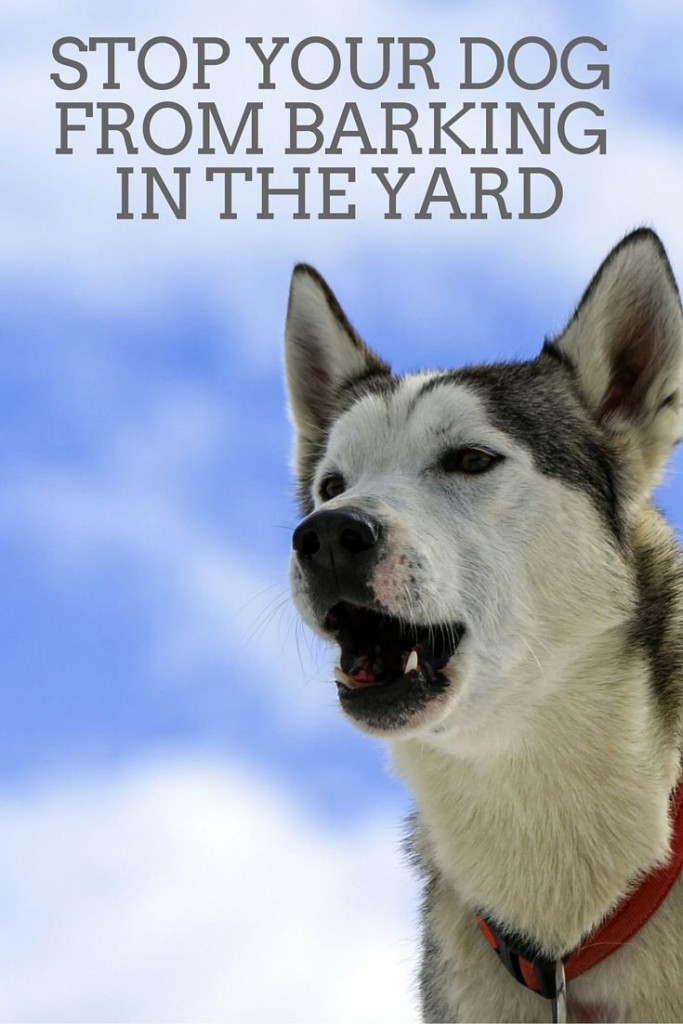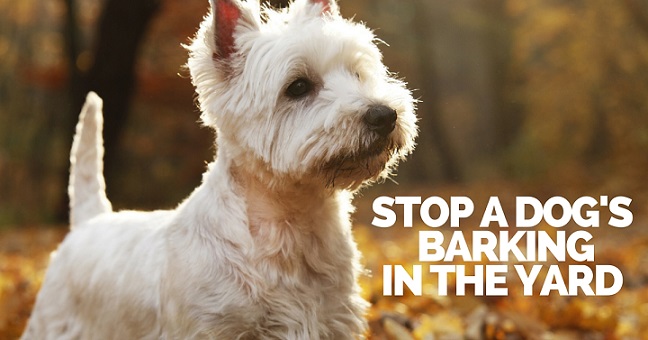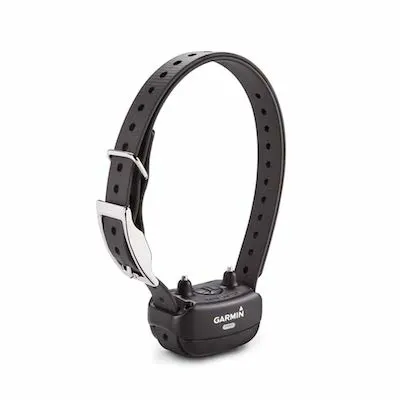Here are my tips on how to stop your dog’s barking in the yard.
It’s so frustrating!
You let your dog out and he will not stop barking at God knows what … neighbor dogs, passing traffic … the wind?
There’s no easy fix to this problem, but last week we focused on stopping a dog’s indoor barking when the dog is home alone.
Today we’ll focus on outdoor barking when the dog is in the yard by himself or with you.
The following are some ideas you can try to stop your dog’s barking in the yard. Just realize it takes time.
As always, please share your questions or ideas in the comments.
How to stop your dog’s barking in the yard

1. First step – Identify “triggers”
What’s causing the barking?
Your dog’s “triggers” could be ANYTHING from squirrels to neighbor dogs to runners to even just being outside without a leash! Like, “Woo! Hoo! Free for all!”
Some triggers are not visual but could be things the dog hears or smells from a distance such as raccoons, machinery down the road, distant truck traffic, ice breaking on the lake, snowmobilers, etc.
Your dog’s triggers could also be things that have passed through your yard previously such as the scent left behind from cats, deer or coyotes the night before.
Also, many dogs have multiple triggers and some just bark out of habit or because they’re bored or have been bored in the past.
To them, being outside equals “Bark! Bark! Bark! Because it’s fun and it’s what I’ve done in the past and I’m a creature of habit.”
Your dog could be barking because of:
- Fear of the trigger (Think fear of fireworks, snowmobiles, other dogs, unfamiliar people)
- Alerting you to the trigger (“potential threat”)
- Trying to scare the trigger away or announce “I’m here!”
- Boredom, because barking is fun or something to do (other problems might be digging or chewing)
Here’s a short video I made going over the tips listed in this post:
2. Find a way to block your dog from the triggers
This probably means reducing your dog’s freedom (for now) by taking her out on a leash.
For the time being, you just have to get control of the barking. That means avoiding your dog’s triggers or managing her around the triggers if they’re unavoidable.
For example, if your dog’s trigger is seeing people walk by on the road, you’d have to let her out at quieter times or take her out on a leash.

By using a leash for now, you’re removing your dog’s option of barking so you can begin teaching her a better response.
3. Start your training …
You’ll need:
- A long lead (15 feet or more)
- Highly valued treats
Once you know your dog’s triggers, work with him on a long lead around mild distractions. A treat pouch is also helpful.
With a long leash, you can give him a little more freedom while still being able to catch him and get his attention as needed.
The basic steps:
– Let him wander around on the long lead around a mild trigger (if that’s possible). So, if his trigger is people walking by on the road, choose a time when there might be one or two people vs. dozens.
– Before he has a chance to bark, calmly but firmly tell him “no” or “hey” and step on the leash. Put yourself between the trigger and your dog and move forward (gently bumping into your dog) so your dog has to take a step back. He’ll be less alert and more focused on you. Tell him to sit or lie down and reward him with the food.
– Hold the food right up to his nose to get his attention if you have to. Reward him for being quiet and looking at you. Keep a foot on the lead to prevent bolting.
– You can even add a “watch me” command if you’d like. Or “quiet.”
– If he ignores you and takes off barking like a maniac, just stay calm, step on the leash and then calmly walk over and get between him and the trigger. This works better than trying to pull him towards you.
‘But my dog doesn’t care about treats when he’s in that state’
Two things:
1. Find highly valued food (Wellness Well Bites, real chicken, pieces of hamburger)
2. You’re challenging him too much. Lessen the intensity of your distractions.
Remember, all of this takes time!
I’m talking two or three 5- to 10-minute sessions every day for a month. Only then will some dogs be ready for off-leash challenges. You’re creating a new habit. That takes time and patience.
Don’t have that kind of time?
Well, most of us don’t!
But, you either make the time or stop complaining about your dog’s barking!

Other tips on how to stop a dog’s barking in the yard
1. Work on general obedience training every day.
Most dogs with severe barking issues don’t respond to the basics like stay, down or come. If he doesn’t listen to you in normal circumstances, why would he listen to you when he’s excited and barking at something?
2. Exercise.
No, this isn’t going to solve your dog’s issue on its own. But it helps. Have you walked him every day this week? Does he need a dog backpack? Do you need a midday dog walker? Does he need dog daycare once a week?
3. Why not hire a professional trainer?
If the issue is causing you frustration, don’t put up with it. Get some help. It’s worth it.
4. Get your dog some puzzle toys. Puzzle toys will give him something to do other than bark! You can also create games for him such as hiding treats in the yard for him to find.
‘But my dog only barks when I’m not in the yard’
This comes back to reducing his freedom (for now). I suggest keeping him indoors when you’re not home or when you can’t be in the yard with him. Then, work with him as listed above.
Also ask yourself, does he really only bark when you’re not home or when you’re not in the yard? Or would he bark if you happened to be in the yard too, but it’s just that you rarely are?
What about anti-bark collars?
Yes, an anti-bark “shock” collar can be one solution to the problem if you’re comfortable with that route. I do not hesitate to recommend anti-bark collars assuming the dog’s needs are being met – plenty of exercise, training and interaction.
Sometimes you just HAVE to stop a dog’s barking for legal reasons or for your own sanity. Sometimes all the positive reinforcement and patience in the world isn’t enough. So yes, go ahead and use an anti-bark “shock” collar if necessary.
OK, so those are my tips. I’ll link to some related posts below. Let me know your ideas in the comments.
Does your dog have a barking issue? What seems to help?
Let me know!
Related posts:
- Stop your dog’s barking at the door
- Keep your dog calm when people visit
- Stop your dog’s barking in the house
- Stop dog’s barking on walks
*This post contains affiliate links



H
Tuesday 10th of August 2021
I think e collars are harsh for barking because it’s a natural behavior. I can understand why people resort to them because neighbors can put threatening notes. I think the training tips are great. I also think you shouldn’t leave a dog alone in the yard for long. Prey drive. Barking. Choking. Much can happen.
Judith Weikum
Thursday 21st of November 2019
Being a foster mom, I thank you so much for giving me great things to do...and to pass on to the one(s) wanting to adopt the dog/ puppy!!
Lindsay Stordahl
Thursday 21st of November 2019
Oh you're welcome!
Kim Chappell
Friday 31st of May 2019
A good article, thank you! Especially like that you mention the dogs mental and physical needs need to be met before considering using a bark collar. The problem with bark collars is that even tho the dog stops barking the dog will often find another way to express itself, like digging chewing or self mutilation instead. Bark collars should NEVER leave burn marks, always buy QUALITY bark collars . I use Garmin and E collar Technologies models, and again - the dogs needs must be met before using a bark collar. I don't recommend the citronella collars as they are unpredictable- if another dog barks or the collared dog bumps something it can set the collar off. The smell lingers, so the dog is getting corrected even when it is not barking. This can cause lots of other behavioral problems.
Rose Stoesz
Saturday 29th of July 2017
Bark Collars are not he answer, we had one on our Beagle and within a month all his fur around his neck was gone and he had a few small burn marks on his neck, and yes we took it off him when he was inside, but that taught us a valuable lesson at the poor dogs expense,never again will we buy or condoneBark Collars.
MikeinTexas
Sunday 7th of May 2017
We have 3 rescue dogs and one has always been afraid of people and noises. She constantly barks at everything. This often causes our other dogs bark. Sara was very sick and underdeveloped when we got her as a foster. We kept her because we knew that she could have ongoing mental and physical problems. We've tried positive calming, socializing, and treats with her and have only minimally reduced barking. As a result we are supplementing quiet positive options with a minimally used hand held ultrasonic device and "no bark" command. It seems to be working as long as it is not used very often. We do not favor this method, but didn't feel that we had any other options, especially since problem was negatively affecting our other dogs.
Lindsay Stordahl
Monday 8th of May 2017
Mike, that sounds like a good way to work on the problem.